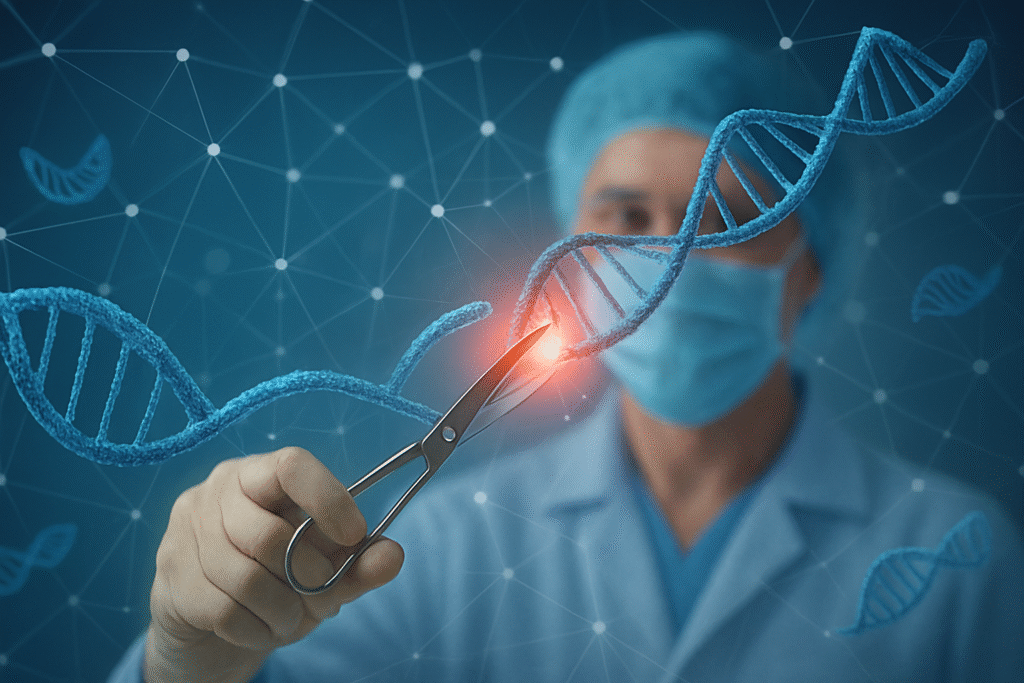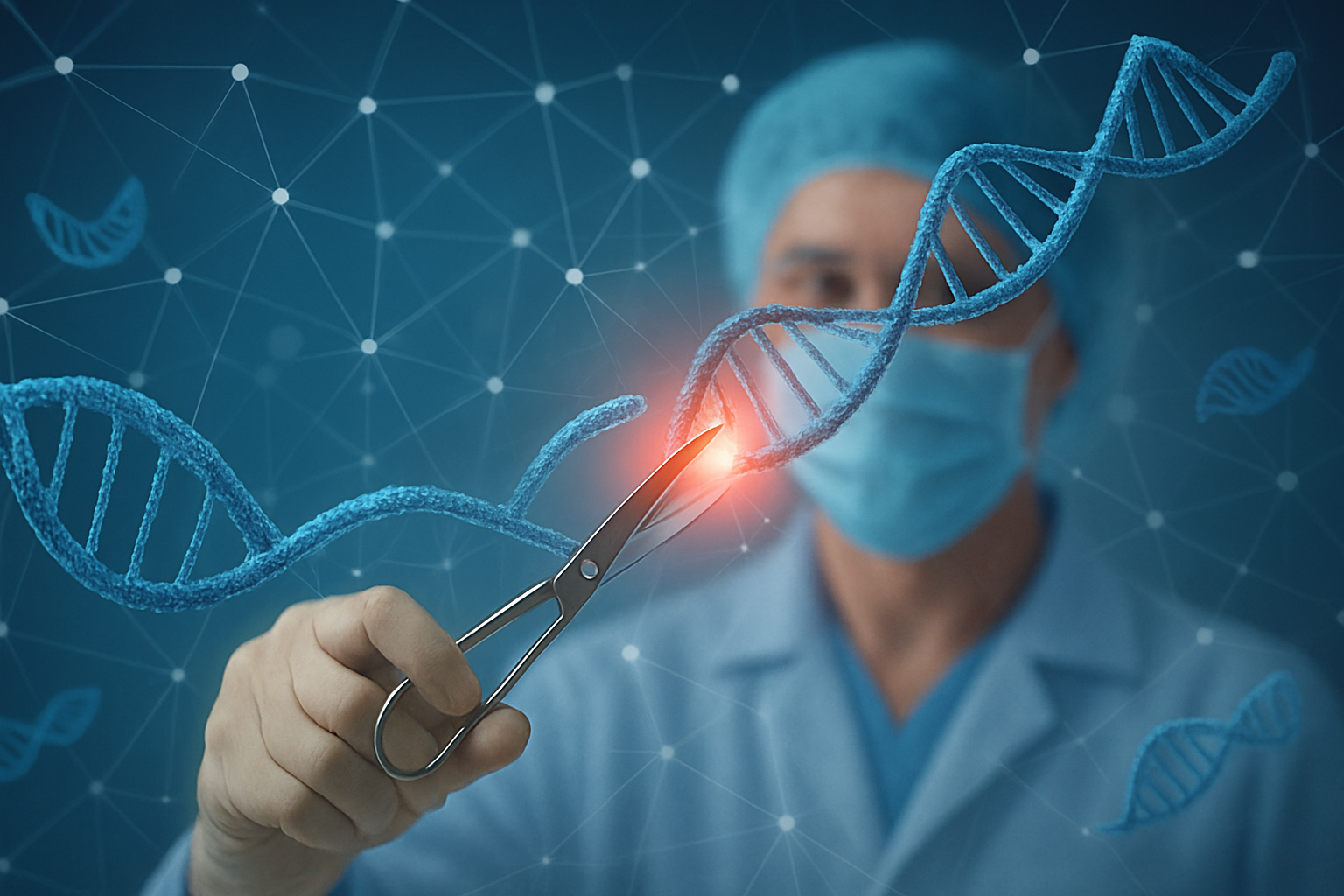
CRISPR-Cas9 is a cutting-edge gene editing tool that allows scientists to cut, delete or substitute specific pieces of DNA. You can think of it as a molecular pair of scissors, and scientists can make the edits just like they would a word in a word document.
- CRISPR stands for Clustered Regularly Interspaced Short Palindromic Repeats.
- Cas9 is an enzyme which cuts the DNA at a targeted site, like scissors
CRISPR-Cas9 gives researchers amazing control and power over the genetic code.
How CRISPR-Cas9 Works
To understand the impact of CRISPR-Cas9, it’s important to grasp its basic mechanism:
- Guide RNA (gRNA): A short synthetic RNA sequence designed to match the DNA region of interest.
- Cas9 Enzyme: A protein that follows the guide RNA to the target location in the genome and makes a cut across both DNA strands.
- DNA Repair: The cell attempts to repair the broken DNA. This is where editing occurs. Scientists can harness this repair process to make precise genetic changes.
There are two primary pathways for DNA repair:
- Non-Homologous End Joining (NHEJ): An error-prone method that often results in gene disruption.
- Homology-Directed Repair (HDR): A more accurate method that can incorporate a supplied DNA template for precise edits.
Revolutionary Applications of CRISPR
CRISPR’s versatility and relative simplicity have unlocked a wide array of applications across various fields
1. Medicine and Human Health
Perhaps the most promising area for CRISPR is in human health. Gene editing offers the potential to correct mutations that cause genetic disorders. Some of the genetic diseases currently being researched or treated using CRISPR include:
- Sickle Cell Anemia
- Beta-Thalassemia
- Cystic Fibrosis
- Huntington’s Disease
- Muscular Dystrophy
In 2023, the UK approved the world’s first CRISPR-based therapy for sickle cell disease and beta-thalassemia, marking a significant milestone in the field of medicine. This therapy involves editing the patient’s stem cells outside the body and then reintroducing them to produce healthy red blood cells.
CRISPR is also being explored in cancer immunotherapy. By modifying T-cells to better recognize and attack tumors, researchers are opening new frontiers in personalized cancer treatment.
2. Agriculture and Food Security
CRISPR gene editing has the potential to revolutionize agriculture by creating crops that are more resistant to pests, diseases, and environmental stresses. Unlike traditional GMOs, which often involve introducing foreign DNA, CRISPR can make precise edits within the plant’s own genome, making the modifications more acceptable to regulatory bodies and the public.
Examples include:
- Disease-resistant wheat and rice
- Tomatoes with longer shelf lives
- Drought-tolerant maize
- Potatoes with reduced levels of harmful compounds
CRISPR-Cas9 gene editing is also being used to improve the nutritional value of crops. For instance, scientists have edited rice to produce higher levels of Vitamin A, addressing malnutrition in some developing countries.
3. Industrial Biotechnology
Beyond medicine and agriculture, CRISPR-Cas9 is making waves in industrial biotechnology. It can be used to engineer microorganisms for biofuel production, waste treatment, and the synthesis of valuable chemicals and pharmaceuticals. Companies are developing yeast and bacteria strains that can efficiently produce bio-based materials, reducing our reliance on fossil fuels.
4. Basic Research and Model Organisms
CRISPR-Cas9 has become a fundamental tool in genetic research. It allows scientists to create model organisms, such as mice and zebrafish, with specific genetic traits. These models help researchers understand the function of genes and the genetic basis of diseases, accelerating the pace of discovery
Ethical and Social Implications
While the scientific community is excited about CRISPR’s potential, it has also sparked significant ethical and social debates. The most controversial application is germline editing, where changes are made to human embryos. These edits would be passed down to future generations, raising concerns about consent, unforeseen consequences, and potential misuse.
In 2018, the world was shocked when a Chinese scientist claimed to have created the first CRISPR-edited babies. This announcement triggered a global outcry and led to calls for tighter regulations and oversight.
Key ethical concerns include:
- Off-target effects: Unintended edits elsewhere in the genome that could cause harm.
- Equity and Access: Who gets access to these powerful technologies? Could they deepen existing social and economic inequalities?
- Designer Babies: The possibility of editing traits like intelligence, appearance, or athletic ability raises questions about the commodification of human life.
To address these concerns, many scientists advocate for a cautious and transparent approach, emphasizing the need for international guidelines and public engagement.
Advancements and Innovations
CRISPR gene editing technology continues to evolve. Newer techniques aim to improve precision and reduce side effects:
- Base Editing: Allows scientists to convert one DNA base into another without cutting the DNA strand, reducing the risk of errors.
- Prime Editing: Combines aspects of CRISPR and reverse transcription to make more complex edits with high accuracy.
- CRISPRa and CRISPRi: Systems that can activate or inhibit gene expression without altering the DNA sequence, useful for studying gene function.
Researchers are also developing delivery systems, such as nanoparticles and viral vectors, to more effectively transport CRISPR components into cells.
Regulatory Landscape
The regulation of CRISPR varies by country. In the United States, the Food and Drug Administration (FDA) oversees clinical applications, while the Department of Agriculture (USDA) and the Environmental Protection Agency (EPA) regulate agricultural uses. The European Union has stricter rules, often treating CRISPR-edited organisms similarly to GMOs. Global collaboration and harmonization of policies are essential to ensure safe and ethical development and deployment of CRISPR technologies.
The Road Ahead
CRISPR gene editing is still a young field, but its impact is already profound. As the technology matures, we can expect it to become more accessible, affordable, and precise. Potential future developments include:
- In vivo gene editing: Delivering CRISPR directly into the body to edit genes in specific tissues.
- Universal donor organs: Editing pigs or other animals to create organs that can be safely transplanted into humans.
- Eradicating vector-borne diseases: Editing mosquitoes to prevent the spread of malaria and other diseases.
As we move forward, it is crucial to strike a balance between innovation and responsibility. CRISPR offers an unprecedented opportunity to reshape our world, but with that power comes the duty to use it wisely and ethically.
Conclusion
In conclusion, CRISPR-Cas9 has changed the field of genetic research. Gene editing has never been faster, easier, and more accurate. The potential for curing genetic diseases, improving crops, and enhancing biotechnology is enormous. Until the possibilities are exhausted, CRISPR will keep moving us towards the future of medicine and biology.
Explore more about the fascinating world of genetic research and its potential applications in fields like cancer research, alongside groundbreaking discoveries such as dinosaur cancer findings.“
❓ Frequently Asked Questions
What is CRISPR-Cas9?
CRISPR-Cas9 is a gene-editing tool that lets scientists cut and modify DNA with incredible precision, helping correct genetic defects.
Can CRISPR really cure genetic diseases?
Yes, CRISPR is already being tested to treat diseases like sickle cell anemia and hereditary blindness, with some promising results.
Is gene editing with CRISPR safe?
It shows great promise but also raises ethical and safety concerns, especially when it comes to editing embryos or heritable genes.
Join the Science Pulses Community
📩 Stay Updated with the Latest Science Discoveries!
Subscribe to our newsletter for weekly insights, breakthroughs, and cutting-edge space science news delivered straight to your inbox.
👉 Subscribe Now



